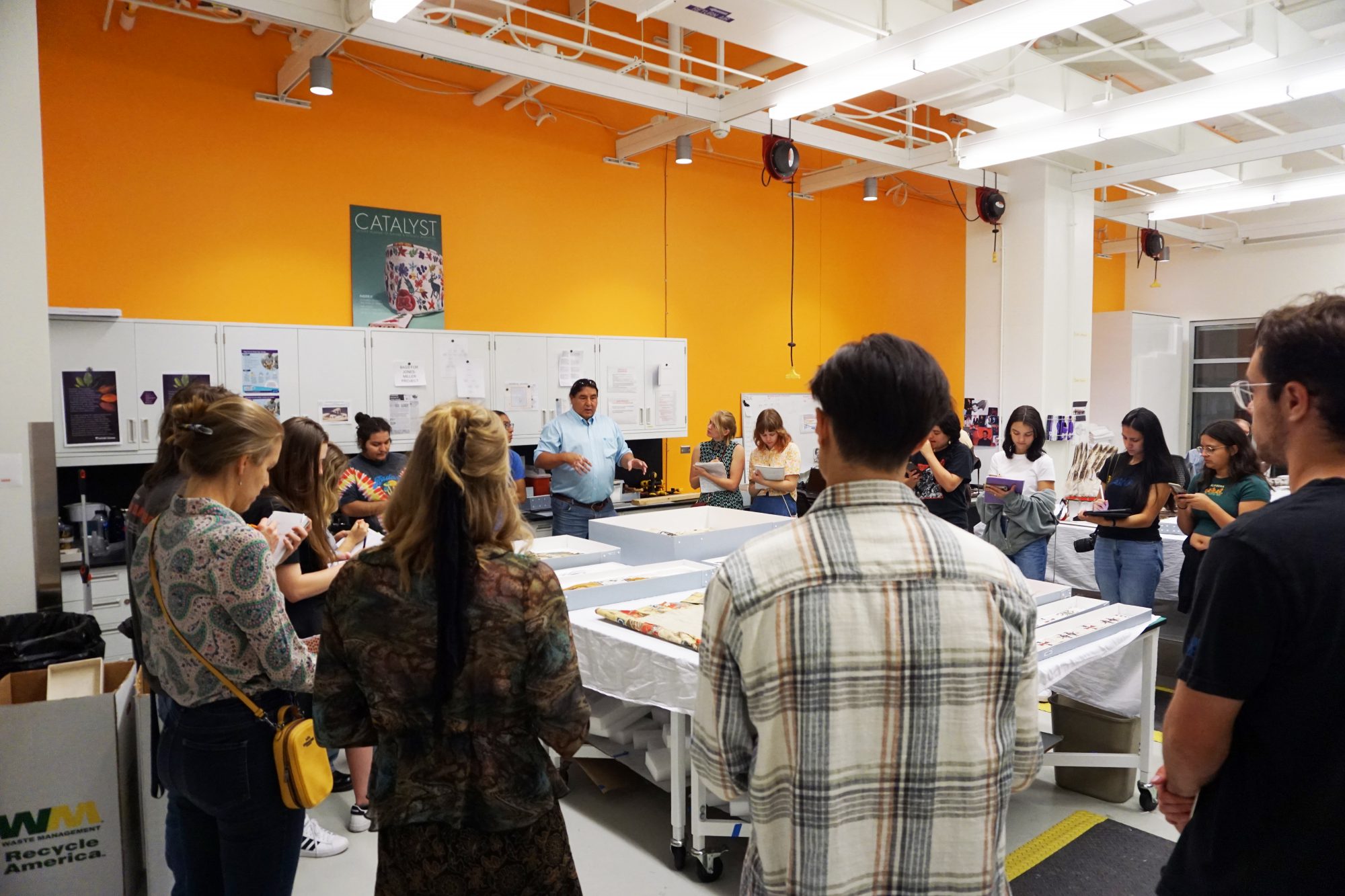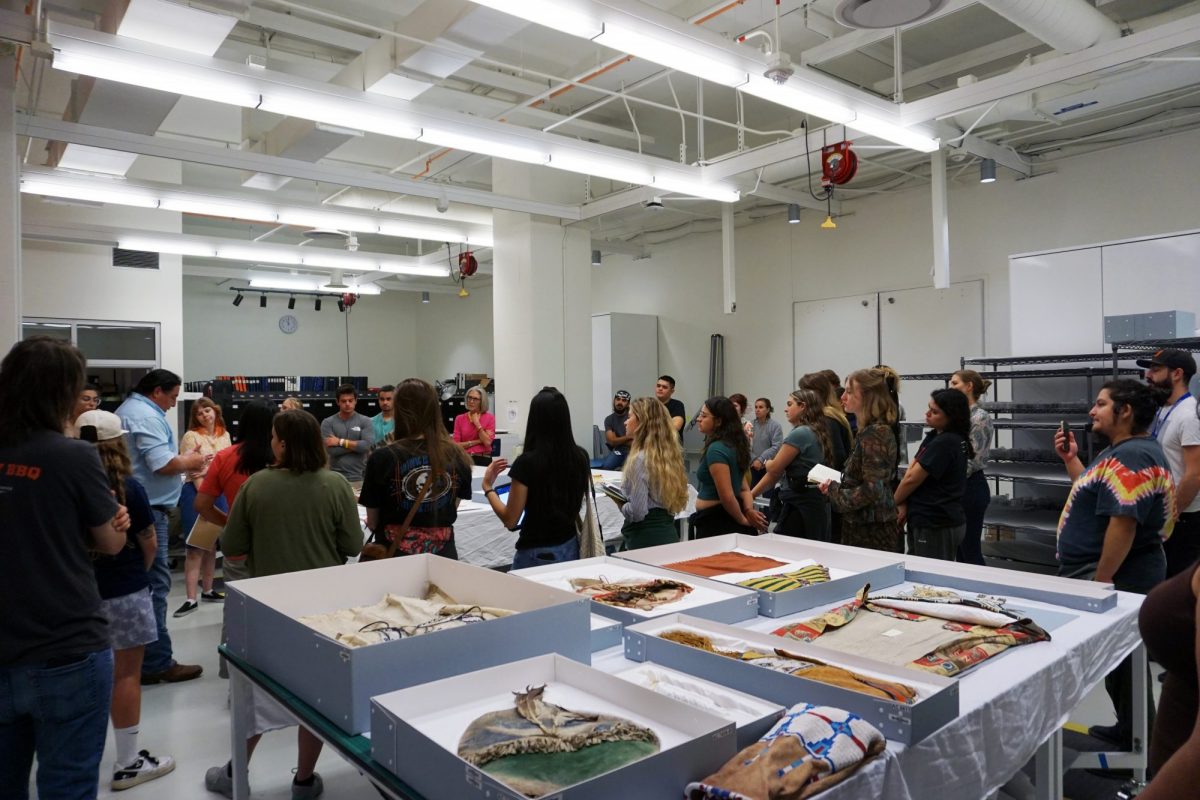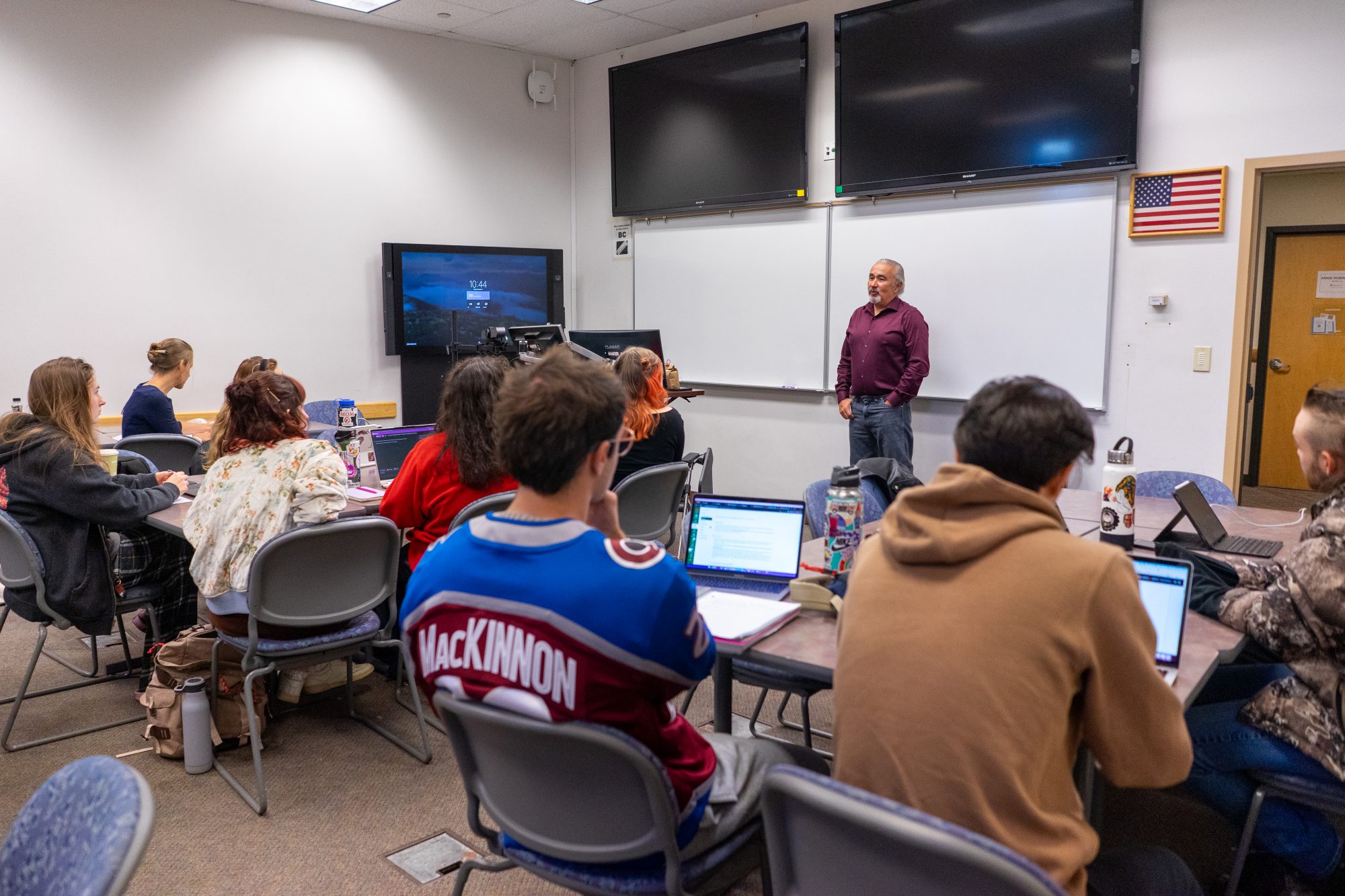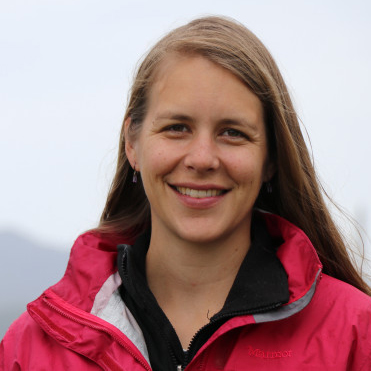
Photo: Artist George Curtis Levi, a member of the Southern Cheyenne Tribe of Oklahoma and Southern Arapaho and Oglala Lakota, meets with students in the Denver Museum of Nature and Science archives.
Students gathered outside the Denver Museum of Nature and Science (DMNS) on a crisp September morning lean in close to hear visiting artist George Curtis Levi, a member of the Southern Cheyenne Tribe of Oklahoma and Southern Arapaho and Oglala Lakota, speak. The students follow him into the institution’s labyrinthine underbelly to learn more about Cheyenne experiences, designs, and craft, and to view cultural belongings from Curtis Levi’s personal as well as the museum’s public collections.
Dr. Emily Moore, associate professor of art history and associate curator at the Gregory Allicar Museum of Art (GAMA), researches American and Native American art. In Fall 2023, she taught ‘Arapaho & Cheyenne Art and History: An exhibition of the arts of θóóxoneeʼnohoʼóoóyóóʼ, the "Front Range," an art history seminar that combines anthropology, museum studies, history, and ethnic studies to provide a more holistic view of Indigenous arts. The course also supports an upcoming exhibition—a recipient of Henry Luce Foundation and Terra Foundation for American Art grants—in the Gregory Allicar Museum of Art’s Griffin Foundation Gallery.
Seminar students met artists and co-curators George Curtis Levi and Bruce Cook, Arapaho from the Wind River Reservation and Haida. Both artists will co-curate the contemporary portion of the exhibition and have supported students’ research as Indigenous knowledge bearers. By bringing their experience and expertise to the project as tribe members and working artists, they provide a deeper context for the historical cultural belongings in the exhibition.
"Part of the mission of this exhibition is to educate the CSU community on the history of our [university] as a land-grant institution," says Moore. "I love the idea of a land-grant institution, but there's a dark history that we need to face up to. We're only starting to do that. Realizing the gravity of the institution we belong to can go a long way in repairing relationships and being more conscientious human beings," she explains.


George Curtis Levi meets with students in the Denver Museum of Nature and Science archives to learn about historical cultural belongings.
After spending time in the DMNS archives with Curtis Levi and learning from Cook in the classroom, students chose a historical cultural belonging borrowed from the Denver Art Museum (DAM) or the DMNS to research for a term paper. From there, the students were tasked with distilling that paper into a 100-word label which will accompany the cultural belongings in the aforementioned exhibition.
“We don’t use the term ‘object’ because it de-animates [these works],” says Moore. “We’re choosing to use the term ‘historical cultural belongings’ because George and Bruce want us to keep in mind that they were part of a culture. ‘Art’ isn’t a great term because they weren’t just meant to be primarily aesthetic, even though they are appreciated for their beauty and skill. They’re so much a part of life.
“I think it's been really eye opening for the students...to do a semester’s worth of research in order to write 100 words. They’re grappling with questions like: ‘how will I interpret this ethically, in a way that respects Indigenous interpretations or knowledge of these cultural belongings? What words do I use? Can I learn the Indigenous term? They are being asked to take on the responsibility of including all the little things that make the cultural belonging significant,” explains Moore.
“We’re choosing to use the term ‘historical cultural belongings’ because George and Bruce want us to keep in mind that they were part of a culture."

This duty to elevate artistic voices and maintain transparency reflects CSU students’ desire to take on impactful research, an excitement Moore has seen in her class. “I've been so impressed that I have students from ethnic studies, history, anthropology, the museum studies certificate, horticulture, and of course, art,” says Moore. “[T]he people who choose to be in [this class] are taking the responsibility seriously... They have a responsibility to represent CSU well and show that we're trying to be earnest about educating ourselves and hopefully building some long-term relationships with Indigenous artists."
Sandrin Molina, who double majors in art with a concentration in painting and ethnic studies with a concentration in global race, power, and resistance, expressed that working on the exhibition provided a distinct opportunity to learn from and work directly with Levi and Cook, as it is an important part of rebuilding relationships with tribes.
“When I first heard about the course, it really intrigued me because it was stated that this would be the first art exhibit dedicated to the Arapaho and Cheyenne art and artists [at CSU], and that it would contain both historical and contemporary work,” says Molina. “I think it's very important that there are co-curators who are part of the tribes. There's this phrase ‘nothing about us without us’ and that has become something I have wanted to uphold. It seemed like a really great opportunity to learn more about the people whose land I'm on.”
Alyssa Myers, senior anthropology major with a concentration in art who is working on museum studies certificate, expressed similar sentiments about the opportunity to work on an original exhibition like this.
“As an anthropology major, I really want to learn more about the Cheyenne and Arapaho people who were here before,” says Myers. “This is a cool way to bridge relationships between what we have now, what our history of the area was, and showcase their art. I'm so happy we can do this because it’s rare as undergraduate students to be able to have these opportunities of looking behind the scenes of museums, working with Indigenous people to build an exhibit, and learning about the people before us.”

Displaying both the historical cultural objects and contemporary art of the tribes is significant for the department, the museum, and CSU. It offers an opportunity to highlight the historical and contemporary art of the Cheyenne and Arapaho and educate the larger Front Range community.
“The major stereotype that you have to contend with in the United States is that Indigenous people are always in the past,” says Moore. “George, Bruce, and I want big visual statements to remind people that even though we're talking about this history in Colorado, and even though Cheyenne, Arapaho communities aren't here on maps, they still exist. We want to center their presence and contemporaneity.”
Accurately and transparently representing the numerous voices involved in exhibitions is crucial for reframing how cultural belongings are represented and displayed. Museums can be good stewards by building equitable relationships with community members and supporting open discussions. And by thoughtfully engaging with cultural belongings and learning from knowledge bearers, art history students at CSU embody the ongoing mandate for cultural professionals at any career level: to keep learning.
